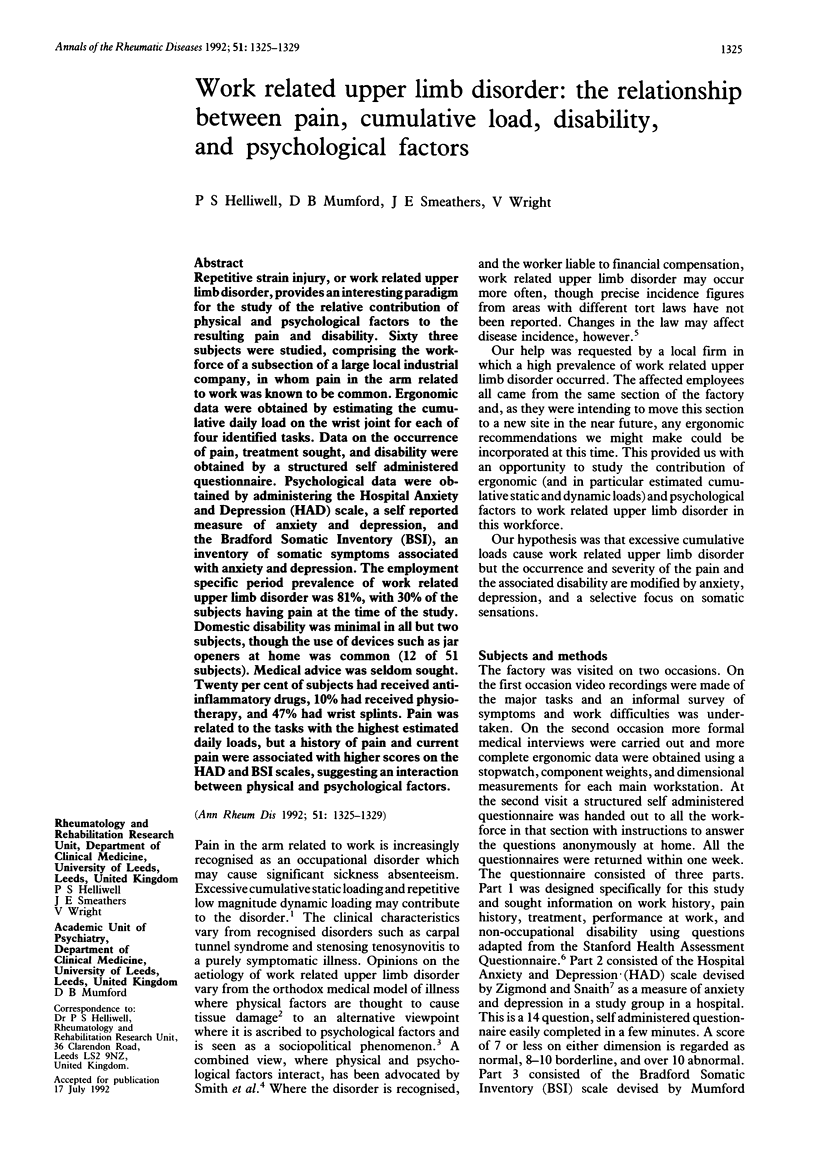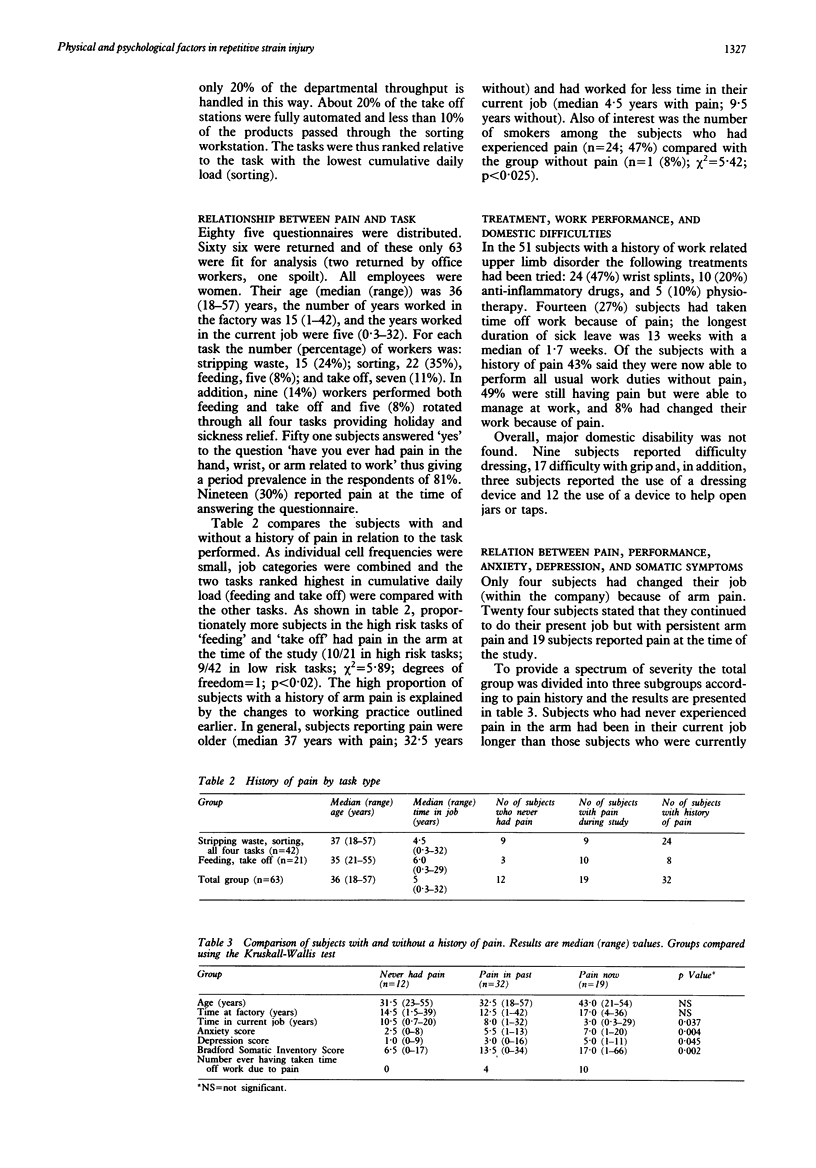Abstract
Repetitive strain injury, or work related upper limb disorder, provides an interesting paradigm for the study of the relative contribution of physical and psychological factors to the resulting pain and disability. Sixty three subjects were studied, comprising the work-force of a subsection of a large local industrial company, in whom pain in the arm related to work was known to be common. Ergonomic data were obtained by estimating the cumulative daily load on the wrist joint for each of four identified tasks. Data on the occurrence of pain, treatment sought, and disability were obtained by a structured self administered questionnaire. Psychological data were obtained by administering the Hospital Anxiety and Depression (HAD) scale, a self reported measure of anxiety and depression, and the Bradford Somatic Inventory (BSI), an inventory of somatic symptoms associated with anxiety and depression. The employment specific period prevalence of work related upper limb disorder was 81%, with 30% of the subjects having pain at the time of the study. Domestic disability was minimal in all but two subjects, though the use of devices such as jar openers at home was common (12 of 51 subjects). Medical advice was seldom sought. Twenty per cent of subjects had received anti-inflammatory drugs, 10% had received physiotherapy, and 47% had wrist splints. Pain was related to the tasks with the highest estimated daily loads, but a history of pain and current pain were associated with higher scores on the HAD and BSI scales, suggesting an interaction between physical and psychological factors.
Full text
PDF




Selected References
These references are in PubMed. This may not be the complete list of references from this article.
- Bigos S. J., Battié M. C., Spengler D. M., Fisher L. D., Fordyce W. E., Hansson T. H., Nachemson A. L., Wortley M. D. A prospective study of work perceptions and psychosocial factors affecting the report of back injury. Spine (Phila Pa 1976) 1991 Jan;16(1):1–6. doi: 10.1097/00007632-199101000-00001. [DOI] [PubMed] [Google Scholar]
- Helliwell P. S. Occupational rheumatology: are we using the wrong model? Br J Rheumatol. 1992 Feb;31(2):73–74. doi: 10.1093/rheumatology/31.2.73. [DOI] [PubMed] [Google Scholar]
- Ireland D. C. Psychological and physical aspects of occupational arm pain. J Hand Surg Br. 1988 Feb;13(1):5–10. doi: 10.1016/0266-7681_88_90041-1. [DOI] [PubMed] [Google Scholar]
- Kamwendo K., Linton S. J., Moritz U. Neck and shoulder disorders in medical secretaries. Part I. Pain prevalence and risk factors. Scand J Rehabil Med. 1991;23(3):127–133. [PubMed] [Google Scholar]
- Kirwan J. R., Reeback J. S. Stanford Health Assessment Questionnaire modified to assess disability in British patients with rheumatoid arthritis. Br J Rheumatol. 1986 May;25(2):206–209. doi: 10.1093/rheumatology/25.2.206. [DOI] [PubMed] [Google Scholar]
- Lucire Y. Neurosis in the workplace. Med J Aust. 1986 Oct 6;145(7):323–327. doi: 10.5694/j.1326-5377.1986.tb113838.x. [DOI] [PubMed] [Google Scholar]
- Mumford D. B., Bavington J. T., Bhatnagar K. S., Hussain Y., Mirza S., Naraghi M. M. The Bradford Somatic Inventory. A multi-ethnic inventory of somatic symptoms reported by anxious and depressed patients in Britain and the Indo-Pakistan subcontinent. Br J Psychiatry. 1991 Mar;158:379–386. doi: 10.1192/bjp.158.3.379. [DOI] [PubMed] [Google Scholar]
- Mumford D. B., Tareen I. A., Bajwa M. A., Bhatti M. R., Pervaiz T., Ayub M. An investigation of 'functional' somatic symptoms among patients attending hospital medical clinics in Pakistan--I. Characteristics of 'non-organic' patients. J Psychosom Res. 1991;35(2-3):245–255. doi: 10.1016/0022-3999(91)90078-3. [DOI] [PubMed] [Google Scholar]
- Reilly P. A., Travers R., LittleJohn G. O. Epidemiology of soft tissue rheumatism: the influence of the law. J Rheumatol. 1991 Oct;18(10):1448–1449. [PubMed] [Google Scholar]
- Smith M. J., Cohen B. G., Stammerjohn L. W., Jr An investigation of health complaints and job stress in video display operations. Hum Factors. 1981 Aug;23(4):387–400. doi: 10.1177/001872088102300402. [DOI] [PubMed] [Google Scholar]


